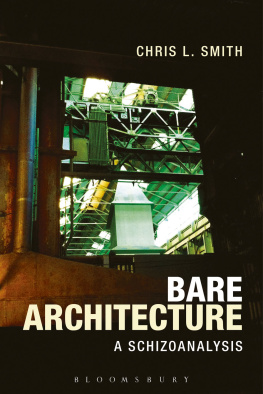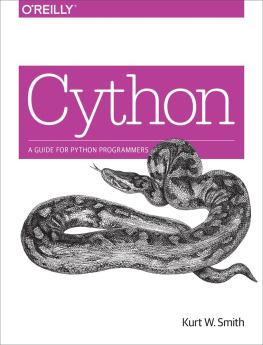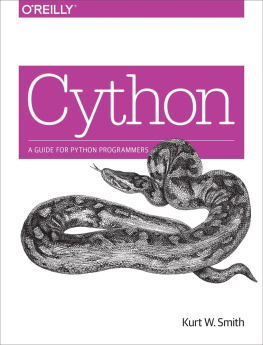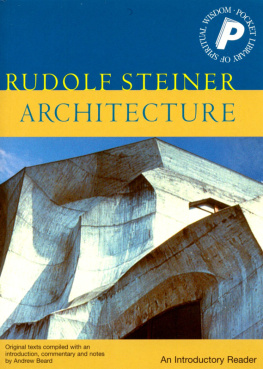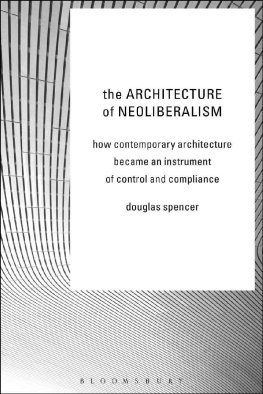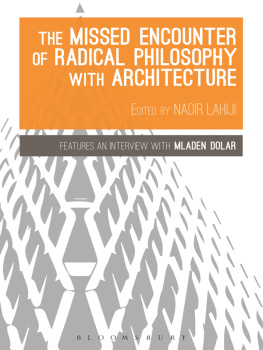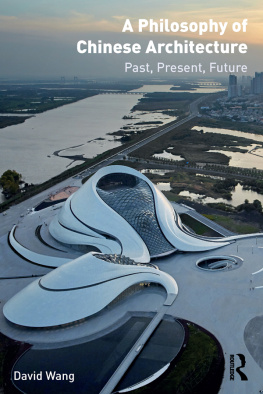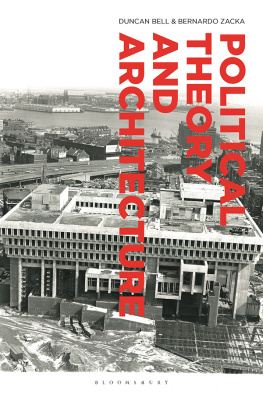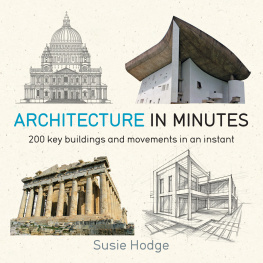Bare Architecture
Also available from Bloomsbury
Schizoanalysis and Ecosophy , edited by Constantin V. Boundas
Schizoanalytic Cartographies , Felix Guattari
Deleuze and the Schizoanalysis of Literature , Ian Buchanan, Tim Matts and Aidan Tynan
Deleuze and the Schizoanalysis of Religion , Lindsay Powell-Jones and F. LeRon Shults
Deleuze and Futurism , Helen Palmer
Deleuze and Cinema , Felicity Colman
Deleuze and Art , Anne Sauvagnargues
Space After Deleuze , Arun Saldanha
To Helen Triantafyllou. Loved.
Bare Architecture: A Schizoanalysis
By Chris L. Smith
Bloomsbury Academic
An imprint of Bloomsbury Publishing Plc
Contents
In the text Schizoanalytic Cartographies (1989), the psychoanalyst Flix Guattari suggests the elements of schizoanalysis are like crystals of singularization, points of bifurcation outside the dominant coordinates, on the basis of which mutant universes of reference can spring up. Schizoanalysis is thus simultaneously an act of departure and flight: a departure from the dominant coordinates of thought the thinking habitually imposed upon a subject. And a flight toward mutant universes alternate modes of critique and creation generative of new subjects. The present book, Bare Architecture , is a work of schizoanalysis. The key model of thought to be departed from is that thinking which we have habitually applied to the body and its relation to architecture. Three poststructural virtues: the impersonal, the indiscernible and the imperceptible, are engaged to recast the subject. Three architectural procedures: symptomatology, wayfaring and speaking, are invoked in order that the architecture that once held us in place, casts us afar.
I am ever grateful for the magnificent mentoring and warm friendship I receive from Andrew Ballantyne. Many of the thoughts herein were given air on a terrace that faces the Basilica of Sainte Marie-Madeleine in Vzelay. Thank you.
Sincere thanks to the University of Sydney for the award of a sabbatical during the period from which this book emerged. I must thank those who have kindly taken the time to read sections of this book and whose critique and commentary has refined many ideas and many more forms of expression: Claudia Perren and Miriam Mlecek, Andrew Leach and David Ellison, Hlne Frichot and Stephen Loo, Ian Buchanan, Michael Tawa, Victoria Jackson Wyatt, Farzane Haghighi, Sanja Mladenovi, Kate King, Vesna Trobec and Kieran Richards.
Thanks to Liza Thompson and Frankie Mace, my editors at Bloomsbury, for their enthusiasm and support throughout. Thanks to Ella Mudie and the Estate of Francis Bacon; Giulia Leali and the Lucian Freud Archive; Paul Rousseau and the John Deakin Archive, and Julian Ridgway and Rosemary Croft from Getty Images, for generous help with the sourcing of images and for sharing magnificent minutiae. Thanks to Allison Collins and Peter Schneider for helping me to access Douglas Dardens wonderful legacy. Thanks also to Joshua Bowler for identifying a figure in a double-exposed photograph that, even for a psychoanalyst, cant have been entirely comfortable.
Heartfelt thanks to those who were with me throughout the intense pre-preamble and post-postscript of this book. Thank you to our four: Terence and Theo Triantafyllou, Byron and Liam Smith. And thank you to Jana Scheffler and Luke Kirchner-Scheffler, Kim Jacobs, Con and Soula Kazantzidis, Shirley Scanes, Lynda and Bill Smith, Ross Anderson and Marjo Niemel for taking such good care of our family across our rawest moment.
Cover
There are moments when we are struck by the sheer brilliance and glow of the Earth. Moments when we are struck by the rhythmic and surging chaos of the shoreline, by waves, by wind and by clouds. There are moments when we feel the force of the Earth directly. Sometimes the force pushes us, blows our hair and warms our skin. At other times the force strikes us hard in silence and stillness. It is often architecture that puts us in proximity to these forces. Platforms that take us over water, towers that take us into the sky. These moments tend to involve at least two sensations thrust together in a complex simultaneity. The first is the sensation of the here and now of being intensely located. Specifically positioned in space and in time, only here and just now . This is the sensation of finding ourselves. The second is the sensation of being dislocated from our centres and our boundaries. Of forgetting the defined extents of who we are and what we can do. Otherwise or whatever . This is the sensation of losing ourselves. It is these dual sensations of finding and losing the self and to their continual passage to which this book turns. I am exploring architecture as a very particular instance of such passage. In this sense, architecture is at once a harbour and a launch-pad. At the end of the platform or the top of a tower we reach for a rail in order to hold us in place lest we completely drift away. And then, just sometimes, we breathe in deeply and let go.
There is a diving tower, a plongeoir, that sits poised above the gentle waves of la grande plage, Carnac (). This diving tower rises approximately 7 metres into the sky, when measured from the shifting sands in which it is anchored. Ive not measured it though, or at least Ive not measured it in any other manner than in the vague measures entailed in the act of climbing the stretching of arms and the bending of knees. The tower is composed of a tubular steel frame and is roughly triangular, or more accurately a square pyramidal frustum . Four legs are spread wide at the base and come closer together at the apex. At this apex a first and second leg bend into a third and fourth respectively. That is, the tubular steel that rises as a first leg is bent in order that it descends as a third, and the steel that rises as a second bends as a fourth; such that the main structure is composed of only two pieces of bent tubular steel. The tower is divided into three equal sections vertically. Each section is marked by a square of horizontal steel tube that acts to brace the legs. The base section is empty (other than the four legs of the tower). The second and third vertical sections have ladders and simple handrails of the same tubular steel, but of a lesser diameter that make these parts easier to grasp. There are two diving platforms that project out from the structure over the water. One platform sits at approximately two-thirds up from the base, the other towards the top approximately six and a half metres into the sky above the shifting sands.

This diving tower sits about 15 metres from the shoreline but this depends on the tide, which in turn depends on the moon, the sun and rotations of the Earth. The tide rises and falls by about 2.5 metres twice a day; more when the moon is full, less when it is new; more in winter when this part of the Earth is closer to the sun, less in summer. This shifting shoreline is located at the southern edge of Carnac, Brittany. It is not far from the thousands of Neolithic stone monoliths that sit across the landscape of Carnac. Thousands of huge stones aligned and organized in manners that are difficult to discern from the Earth but that seem more obvious when viewed from the sky, as if they are wayfaring devices for gods. Brittany was once a kingdom, then a duchy, then a province and is currently a region of France. The peninsula of Brittany is the north-west tip of Continental Europe. Or, from the other direction, it can be said that this diving tower of la grande plage, occupies the waters of Quiberon Bay and Quiberon Bay is of the waters of the Bay of Biscay and the Celtic Sea and these bays and this sea occupy the waters of the North Atlantic Ocean. This tower, this diving tower, is a marking of a particular place. A geographic point or pointer. In many senses its more stable than its geography. Like the monolithic stones of the fields, this tower is the carving of territory out of the chaos of the sea and the sky, a temporary stability in the shifting of sands; the rolls of the tides; of lunar cycles and the spinning of the Earth; of socio-political assignations and borders, and; of the perpetual migrations of waters.

